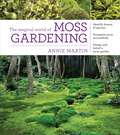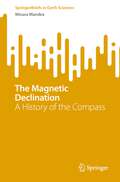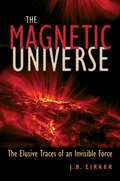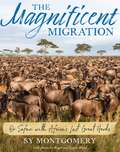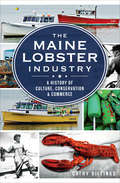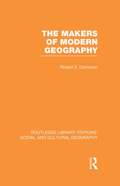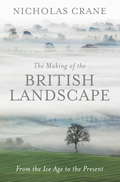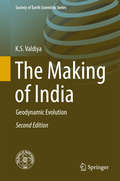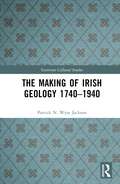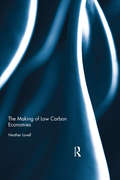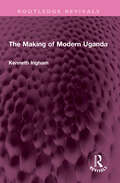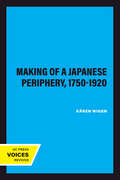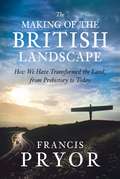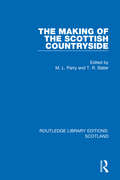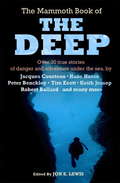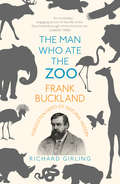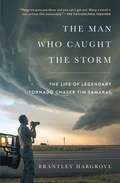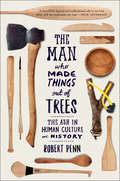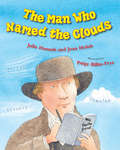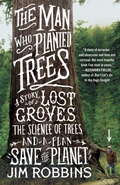- Table View
- List View
The Magical World of Moss Gardening
by Annie Martin“This is a fascinating books for anyone wanting to truly broaden the range of plants they grow.” —Gardens Illustrated Moss is an extraordinary plant—it grows without roots, flowers, or stems. Despite being overlooked, in many ways, moss is perfect: it provides year-round color, excels in difficult climates, prevents soil erosion, and resists pests and disease. In The Magical World of Moss Gardening, bryophyte expert Annie Martin reveals how moss can be used in stunning, eco-friendly spaces. The beautifully illustrated guide includes basics on designing and planting a moss garden, as an inspiring tour of the most magical public and private moss gardens throughout the country.
The Magnetic Declination: A History of the Compass (SpringerBriefs in Earth Sciences)
by Mioara MandeaThis book aims then to describe in a comprehensible way efforts made over centuries of measuring and understanding the magnetic declination. The book also highlights some important characteristics of the Earth’s magnetic field thanks to the declination measurements. Some applications and societal implications are also underlined. Anyone living in the 21st century knows the best way to navigate is by using a smartphone App. Decades and centuries ago, in order to find the same way a magnificent instrument was used: the compass. Despite many being aware of the compass, not everyone appreciates that throughout the ages of exploration, sailors and explorers linked their lives and great discoveries to the magnetic needle. Furthermore, is there an awareness of the Earth’s physical mechanism behind the changes in time and space of the direction indicated by the compass? The magnetic declination is at the center of this book and it helps the reader to understand how to navigate in time and space. The book provides the history of the compass and magnetic declination leading the reader to the understanding of our magnetic planet.This book is designed for those who are fascinated by the long history of geomagnetism. This book relies on reader’s knowledge of elementary scientific concepts, and introduces the geomagnetism concepts as they evaluated in time. The focus is on some basic concepts and physical processes in order to understand the evolution of a specific element of the geomagnetic field, the declination. The primary audience may have just started an interest in the geomagnetism and history of science, as students and researchers. Some readers may have an interest that only touches the geomagnetism, as navigators, geophysicists, historians.
The Magnetic Universe: The Elusive Traces of an Invisible Force
by J. B. ZirkerA main selection of Scientific American Book ClubMagnetic fields permeate our vast universe, urging electrically charged particles on their courses, powering solar and stellar flares, and focusing the intense activity of pulsars and neutron stars.Magnetic fields are found in every corner of the cosmos. For decades, astrophysicists have identified them by their effects on visible light, radio waves, and x-rays. J. B. Zirker summarizes our deep knowledge of magnetism, pointing to what is yet unknown about its astrophysical applications. In clear, nonmathematical prose, Zirker follows the trail of magnetic exploration from the auroral belts of Earth to the farthest reaches of space. He guides readers on a fascinating journey of discovery to understand how magnetic forces are created and how they shape the universe. He provides the historical background needed to appreciate exciting new research by introducing readers to the great scientists who have studied magnetic fields. Students and amateur astronomers alike will appreciate the readable prose and comprehensive coverage of The Magnetic Universe.
The Magnetotelluric Method
by Alan D. Chave Alan G. JonesThe magnetotelluric method is a technique for imaging the electrical conductivity and structure of the Earth, from the near surface down to the 410 km transition zone and beyond. This book forms the first comprehensive overview of magnetotellurics from the salient physics and its mathematical representation, to practical implementation in the field, data processing, modeling and geological interpretation. Electromagnetic induction in 1-D, 2-D and 3-D media is explored, building from first principles, and with thorough coverage of the practical techniques of time series processing, distortion, numerical modeling and inversion. The fundamental principles are illustrated with a series of case histories describing geological applications. Technical issues, instrumentation and field practices are described for both land and marine surveys. This book provides a rigorous introduction to magnetotellurics for academic researchers and advanced students and will be of interest to industrial practitioners and geoscientists wanting to incorporate rock conductivity into their interpretations.
The Magnificent Migration: On Safari with Africa's Last Great Herds
by Sy MontgomerySibert medalist and National Book Award finalist Sy Montgomery takes readers on a staggering, emotional journey alongside the greatest land migration on the planet earth—that of the wildebeest across the Serengeti—to explore the mystery and wonder of migration in a sweeping story sure to leave its mark. With full color photography. Sibert medalist Sy Montgomery takes readers on a staggering, emotional journey alongside the greatest land migration on earth—that of the wildebeest across the Serengeti—to provide a you-are-there account of one of nature’s most fascinating occurrences. Montgomery explores the wonder of migration, asking questions like, how do migration patterns sculpt the environment? Why do animals migrate? And how do they know where to go? With lyrical prose, abundant facts, and the inclusion of other species who undertake remarkable migrations, Montgomery makes a journey of thousands of miles fly by—but not without leaving its mark. Full color photography.
The Maine Lobster Industry: A History of Culture, Conservation & Commerce
by Cathy BillingsAn inside look at the history and traditions behind this New England delicacy. Since the first recorded lobster catch in 1605, the Maine lobster fishery has grown into a multibillion-dollar force. In this book, Cathy Billings of the University of Maine Lobster Institute embarks on a journey from trap to plate, introducing readers to lobstermen, boat builders, bait dealers, marine suppliers, and the expansive industry that revolves around the fishery. Maine lobster families extend for generations back, and strides in sustainability have been a hallmark of the Maine fishery throughout the centuries—from the time lobstermen themselves introduced conservation measures in the mid-1800s. Today, Maine&’s lobster fishery is a model of a co-managed, sustainable fishery. The people who work Maine&’s lobster fishery have developed a coastal economy with an international influence and deep history, and this book takes you behind the scenes.
The Maine Woods
by Henry David Thoreau Edward Hoagland"What a wilderness walk for a man to take alone!...Here was traveling of the old heroic kind over the unaltered face of nature." Henry David Thoreau Over a period of three years, Thoreau made three trips to the largely unexplored woods of Maine. He climbed mountains, paddled a canoe by moonlight, and dined on cedar beer, hemlock tea and moose lips. Taking notes constantly, Thoreau was just as likely to turn his observant eye to the habits and languages of the Abnaki Indians or the arduous life of the logger as he was to the workings of nature. He acutely observed the rivers, lakes, mountains, wolves, moose, and stars in the dark sky. He also told of nights sitting by the campfire, and of meeting men who communicated with each other by writing on the trunks of trees. In The Maine Woods, Thoreau captured a wilder side of America and revealed his own adventurous spirit.
The Makers of Modern Geography (Routledge Library Editions: Social and Cultural Geography)
by Robert E. DickinsonThis book examines the works of the outstanding makers of modern geography and demonstrates the consistency of idea and purpose in their work. Geography as an explicitly defined field of knowledge is more than two thousand years old, but as a university subject, geography is only 150 years old, and in this period it has developed hugely. This study traces the development of modern geography as an organized body of knowledge, in the light of the works of its foremost German and French contributors.
The Making Of The British Landscape: From the Ice Age to the Present
by Nicholas CraneHow much do we really know about the place we call 'home'? In this sweeping, timely book, Nicholas Crane tells the story of Britain.*****Over the course of 12,000 years of continuous human occupation, the British landscape has been transformed form a European peninsula of glacier and tundra to an island of glittering cities and exquisite countryside.In this geographical journey through time, we discover the ancient relationship between people and place and the deep-rooted tensions between town and countryside. From tsunamis to Roman debacles, from henge to high-rise and hamlet to metropolis, this is a book about change and adaptation. As Britain lurches towards a more sustainable future, it is the story of our age.'A geographer's love letter to the British and the land that formed them ... dramatic, lyrical and even inspiring' Sunday Times'A magnificent, epic work by a national treasure ... A tour de force' Bel Mooney, Daily Mail
The Making of Auschwitz: The Largest Killing Factory of all time
by Ian Baxter"A chilling blueprint for genocide, The Making of Auschwitz uncovers the deadly architecture behind the largest mass murder factory in history."Commemorating 80 years since the liberation of Auschwitz-Birkenau, The Making of Auschwitz reveals the chilling construction of the largest mass murder factory in history. Drawing from hundreds of captured German documents, architectural plans, and key records from the Building Office archive, this book provides a unique historical source detailing the architectural and operational planning behind the genocide. It explores how the SS relied on civilian expertise to install crucial systems like electricity, sewage, and heating, and how external contractors eagerly participated for financial gain. From the earliest days of Birkenau's construction in 1941 to the inclusion of crematoria and gas chambers by 1943, the book traces the evolution of the camp into an industrial killing machine. Despite Himmler&’s order in 1944 to dismantle the extermination facilities, many structures remained intact when the Red Army arrived on January 27, 1945. The discovery of crucial construction blueprints, untouched by the SS&’s attempt to destroy them, offers an undeniable record of the atrocities planned and executed at Auschwitz. With rare photographs, detailed captions, and a comprehensive analysis, this book provides an essential study of those responsible for the murder of over 1 million people.
The Making of Citizens: Cities of Peasants Revisited
by Bryan RobertsOriginally published as 'Cities of Peasants', this highly-acclaimed account of the expansion of capitalism in the developing world has now been extensively rewritten and updated.Focusing on Latin America, Bryan Roberts traces the evolution of developing societies and their economies to the present. Taking account of the move towards more 'open' economies, a shrinking of the state and various transitions towards democracies, he shows how urban growth has produced new patterns of social stratification, creating opportunities for social mobility, but doing little to decrease income inequality or political and social pressures.Underlying social changes have broadened the practice of citizenship in developing countries, limiting authoritarian rule but within a context of entrenched social inequalities and persisting political instability. This book conveys both the flavour of life in the cities of the third world and the immediacy of their problems.
The Making of India
by K. S. ValdiyaThis book presents in a concise format a simplified and coherent geological-dynamical history of the Indian subcontinent (including Sri Lanka, Bangladesh, Myanmar, Southern Tibet and Pakistan). Encompassing a broad array of information related to structure and tectonics, stratigraphy and palaeontology, sedimentation and palaeogeography, petrology and geochemistry, geomorphology and geophysics, it explores the geodynamic developments that took place from the beginning around 3. 4 billion years ago to the last about 5,000 years before present. Presented in a distilled form, the observations and deductions of practitioners, this book is meant for teachers, researchers and students of geology, geophysics and geomorphology and practitioners of earth sciences. A comprehensive list of references to original works provides guidance for those seeking further details and who wish to examine selected problems in depth. The book is illustrated with a wealth of maps, cross sections and block diagrams -- all simplified and redesigned.
The Making of Irish Geology 1740–1940 (Variorum Collected Studies)
by Patrick N. Wyse JacksonIreland has long been the focus of research into its geological foundations and history. This book provides insights into the evolution of geological ideas in Ireland, gives assessments of underrepresented scientists, and offers an appreciation of the value of geological collections for historical research.Through a series of twenty-two papers, this volume provides syntheses and analyses of aspects of this geological research and places the role of a number of individuals firmly within context. The topics discussed include the considerations of the nature of igneous rocks, aspects of geological mapping of the country, the role played by Irish scientists in determining the age of the Earth, and the importance of early mineralogical and geological collectors and the role their collections made to advancing geological knowledge both in Ireland and Europe. The Making of Irish Geology 1740–1940 will appeal to both the general and academic reader interested in the development of the geological sciences, with a particular focus on Ireland.
The Making of Low Carbon Economies
by Heather LovellThe Making of Low Carbon Economies looks at how more than two decades of sustained effort at climate change mitigation has resulted in a variety of new practices, rules and ways of doing things: a period of active construction of low carbon economies. From outer space observations of the carbon in tropical forests, to carbon financial reporting, and insulating solid masonry walls, these diverse things, activities and objects are integral to how climate change has been brought into being as a problem. The book takes a fresh look at society’s response to climate change by examining a diverse array of empirical sites where climate change is being made real through its incorporation into everyday lives – a process of stitching climate concerns into the discourse and practices of already existing economies, as well as creating new economies. The Making of Low Carbon Economies adds fresh insights to economic sociology and science and technology studies scholarship on the multiple origins and heterogeneous operation of markets, demonstrating the constraints and opportunities of an economic framing of the problem of climate change. It covers the obvious (and now well-researched) topic of carbon markets, as well as new more unusual material on the low carbon reframing of already existing markets and economies.
The Making of Modern Uganda (Routledge Revivals)
by Kenneth InghamFirst published in 1958, The Making of Modern Uganda is concerned with the formation of modern Uganda in the sixty years since the 1890s when the foundations of the British administration were laid. In the first decade of the 20th century Sir Hesketh Bell, Uganda’s Governor, decided that Uganda should be built up by Africans under the disinterested guidance of Europeans. The book therefore traces the emergence of a territory whose material prosperity is mainly based upon peasant agriculture guided by the advice of British agricultural officers. It describes the development from an era of tribal, clan and even village organisation to the system of centralised government along semi-parliamentary lines but notes the disagreement as to whether Uganda’s future should lie as a unitary or a federal state. The controversial issue of closer union with the other East African territories is studied at some length as also is the growth of the politically active minority which plays so important a part in the modern Protectorate. The author believes that the years of ‘happy Uganda’, the years before the Second World War, were a period in which hard work coupled with peace and obvious progress tended to conceal for many the growth of new forces which needed an outlet and only found one in the political and constitutional developments of the post-war age. This book will be of interest to students of history, African studies, ethnic studies and political science.
The Making of a Japanese Periphery, 1750-1920 (Twentieth Century Japan: The Emergence of a World Power #3)
by Kären WigenContending that Japan's industrial and imperial revolutions were also geographical revolutions, Kären Wigen's interdisciplinary study analyzes the changing spatial order of the countryside in early modern Japan. Her focus, the Ina Valley, served as a gateway to the mountainous interior of central Japan. Using methods drawn from historical geography and economic development, Wigen maps the valley's changes—from a region of small settlements linked in an autonomous economic zone, to its transformation into a peripheral part of the global silk trade, dependent on the state. Yet the processes that brought these changes—industrial growth and political centralization—were crucial to Japan's rise to imperial power. Wigen's elucidation of this makes her book compelling reading for a broad audience.
The Making of the British Landscape: How We Have Transformed the Land, from Prehistory to Today
by Francis PryorThis is the changing story of Britain as it has been preserved in our fields, roads, buildings, towns and villages, mountains, forests and islands. From our suburban streets that still trace out the boundaries of long vanished farms to the Norfolk Broads, formed when medieval peat pits flooded, from the ceremonial landscapes of Stonehenge to the spread of the railways - evidence of how man's effect on Britain is everywhere. In The Making of the British Landscape, eminent historian, archaeologist and farmer, Francis Pryor explains how to read these clues to understand the fascinating history of our land and of how people have lived on it throughout time. Covering both the urban and rural and packed with pictures, maps and drawings showing everything from how we can still pick out Bronze Age fields on Bodmin Moor to how the Industrial Revolution really changed our landscape, this book makes us look afresh at our surroundings and really see them for the first time.
The Making of the Scottish Countryside (Routledge Library Editions: Scotland #23)
by T. R. Slater M. L. ParryOriginally published in 1980, this book examines the evolution of the Scottish landscape from pre-historic times to the mid-nineteenth century. It considers the way in which the structural base of agriculture and the changing farming ‘system’ came to alter the Scottish rural landscape. This book, with its focus on the underlying landscape processes, gives a developmental view of landscape change. It therefore considers the crucial question of the rate and pace of landscape change and argues that the Scottish landscape was not the product of a few brief phases of quite rapid development but rather the result of a continual and gradual process of change. It also looks at the regional variation of landscape change and establishes the importance of regional linkages in the diffusion of ideas especially in new technology.
The Mammoth Book of The Deep (Mammoth Books #389)
by Jon E. LewisDive in. Death is only a breath away&Encounter great white sharks, the stricken Kursk submarine, gold salvagers, sponge divers, giant squid, the wreck of the Titanic, Navy frogmen, and bathyscopes in record-breaking descents in The Mammoth Book of the Deep. These riveting accounts range from the Red Sea to the South Pacific, from the North Atlantic to the Caribbean - and include contributions by names such as Jacques Cousteau, Hans Hasse, Peter Benchley and Tim 'Neutral Buoyancy' Ecott.Includes:Goldfinder: Keith Jessop - salvaging the gold cargo from HMS Edinburgh Black Water: Don Camsell - an SBS training operation aboard a mini-sub goes tragically wrong off the coast of Scotland A Time to Die: Robert Moore - the operation to rescue the trapped submariners of the Kursk Discovering the Titanic: Robert Ballard - the world's foremost wreck-hunter on the world's greatest wreck Descent: William Beebe - the record breaking descent in a bathysphere off Bermuda, 1934 World Without Sun: Jacques Cousteau - the famous experiment in living for a month on the sea bed
The Mammoth Book of The Deep: Over 30 True Stories Of Danger And Adventure Under The Sea (Mammoth Books)
by Jon E. LewisDive in. Death is only a breath away&Just when you thought it was safe & The Mammoth Book of The Deep presents 30 true-life stories of danger, endurance and adventure from this final frontier. Encounter great white sharks, the stricken Kursk submarine, gold salvagers, sponge divers, giant squid, the wreck of the Titanic, Navy frogmen, and bathyscopes in record-breaking descents. These riveting accounts range from the Red Sea to the South Pacific, from the North Atlantic to the Caribbean - and include contributions by names such as Jacques Cousteau, Hans Hasse, Peter Benchley and Tim 'Neutral Buoyancy' Ecott.Includes:Goldfinder: Keith Jessop - salvaging the gold cargo from HMS Edinburgh Black Water: Don Camsell - an SBS training operation aboard a mini-sub goes tragically wrong off the coast of Scotland A Time to Die: Robert Moore - the operation to rescue the trapped submariners of the Kursk Discovering the Titanic: Robert Ballard - the world's foremost wreck-hunter on the world's greatest wreck Descent: William Beebe - the record breaking descent in a bathysphere off Bermuda, 1934 World Without Sun: Jacques Cousteau - the famous experiment in living for a month on the sea bed
The Man Who Ate the Zoo: Frank Buckland, forgotten hero of natural history
by Richard GirlingFrank Buckland was an extraordinary man – surgeon, natural historian, popular lecturer, bestselling writer, museum curator, and a conservationist before the concept even existed. Eccentric, revolutionary, prolific, he was one of the nineteenth century’s most improbable geniuses. His lifelong passion was to discover new ways to feed the hungry. Rhinoceros, crocodile, puppy-dog, giraffe, kangaroo, bear and panther all had their chance to impress, but what finally - and, eventually, fatally - obsessed him was fish. Forgotten now, he was one of the most original, far-sighted and influential natural scientists of his time, held as high in public esteem as his great philosophical enemy, Charles Darwin.
The Man Who Caught the Storm: The Life of Legendary Tornado Chaser Tim Samaras
by Brantley Hargrove“An instant classic of Americana—a story of tragedy, invention, lore, science, and a most original kind of genius.” —Hampton Sides “Masterful. This is what man versus nature is all about.” —Skip Hollandsworth The Man Who Caught the Storm is the saga of the greatest tornado chaser who ever lived: a tale of obsession and daring, and an extraordinary account of humanity’s high-stakes race to understand nature’s fiercest phenomenon.At the turn of the twenty-first century, the tornado was one of the last true mysteries of the modern world. It was a monster that ravaged the American heartland a thousand times each year, yet science’s every effort to divine its inner workings had ended in failure. Researchers all but gave up, until the arrival of an outsider. In a field of PhDs, Tim Samaras didn’t attend a day of college in his life. He chased storms with brilliant tools of his own invention and pushed closer to the tornado than anyone else ever dared. When he achieved what meteorologists had deemed impossible, it was as if he had snatched the fire of the gods. Yet even as he transformed the field, Samaras kept on pushing. As his ambitions grew, so did the risks. And when he finally met his match—in a faceoff against the largest tornado ever recorded—it upended everything he thought he knew. Brantley Hargrove delivers a masterful tale, chronicling the life of Tim Samaras in all its triumph and tragedy. He takes readers inside the thrill of the chase, the captivating science of tornadoes, and the remarkable character of a man who walked the line between life and death in pursuit of knowledge. Following the tradition of Into Thin Air and The Perfect Storm, Hargrove’s debut offers an unforgettable exploration of obsession and the extremes of the natural world.
The Man Who Made Things Out of Trees
by Robert PennThe story of how one man cut down a single tree to see how many things could be made from it.Out of all the trees in the world, the ash is most closely bound up with who we are: the tree we have made the greatest and most varied use of over the course of human history. One frigid winter morning, Robert Penn lovingly selected an ash tree and cut it down. He wanted to see how many beautiful, handmade objects could be made from it. Thus begins an adventure of craftsmanship and discovery. Penn visits the shops of modern-day woodworkers--whose expertise has been handed down through generations--and finds that ancient woodworking techniques are far from dead. He introduces artisans who create a flawless axe handle, a rugged and true wagon wheel, a deadly bow and arrow, an Olympic-grade toboggan, and many other handmade objects using their knowledge of ash's unique properties. Penn connects our daily lives back to the natural woodlands that once dominated our landscapes. Throughout his travels--from his home in Wales, across Europe, and America--Penn makes a case for the continued and better use of the ash tree as a sustainable resource and reveals some of the dire threats to our ash trees. The emerald ash borer, a voracious and destructive beetle, has killed tens of millions of ash trees across North America since 2002. Unless we are prepared to act now and better value our trees, Penn argues, the ash tree and its many magnificent contributions to mankind will become a thing of the past. This exuberant tale of nature, human ingenuity, and the pleasure of making things by hand chronicles how the urge to understand and appreciate trees still runs through us all like grain through wood.
The Man Who Named the Clouds
by Joan Holub Paige Billin-Frye Julie HannaIn 1782, when Luke Howard was ten, he began keeping a weather journal to describe what he saw in the sky--he especially loved to watch the clouds. As an adult, Luke wanted to classify clouds, though many others had failed at this.
The Man Who Planted Trees: A Story of Lost Groves, the Science of Trees, and a Plan to Save the Planet
by Jim RobbinsTHIS BOOK JUST MIGHT SAVE THE PLANET "When is the best time to plant a tree? Twenty years ago. The second best time? Today."--Chinese proverb Twenty years ago, David Milarch, a northern Michigan nurseryman with a penchant for hard living, had a vision: angels came to tell him that the earth was in trouble. Its trees were dying, and without them, human life was in jeopardy. The solution, they told him, was to clone the champion trees of the world--the largest, the hardiest, the ones that had survived millennia and were most resilient to climate change--and create a kind of Noah's ark of tree genetics. Without knowing if the message had any basis in science, or why he'd been chosen for this task, Milarch began his mission of cloning the world's great trees. Many scientists and tree experts told him it couldn't be done, but, twenty years later, his team has successfully cloned some of the world's oldest trees--among them giant redwoods and sequoias. They have also grown seedlings from the oldest tree in the world, the bristlecone pine Methuselah. When New York Times journalist Jim Robbins came upon Milarch's story, he was fascinated but had his doubts. Yet over several years, listening to Milarch and talking to scientists, he came to realize that there is so much we do not yet know about trees: how they die, how they communicate, the myriad crucial ways they filter water and air and otherwise support life on Earth. It became clear that as the planet changes, trees and forest are essential to assuring its survival. The Man Who Planted Trees is both a fascinating investigation into the world of trees and the inspiring story of one man's quest to help save the planet. This book's hopeful message of what one man can accomplish against all odds is also a lesson about how each of us has the ability to make a difference. This book was printed in the United States of America on Rolland EnviroTM 100 Book, which is manufactured using FSC-certified 100% postconsumer fiber and meets permanent paper standards.From the Hardcover edition.
